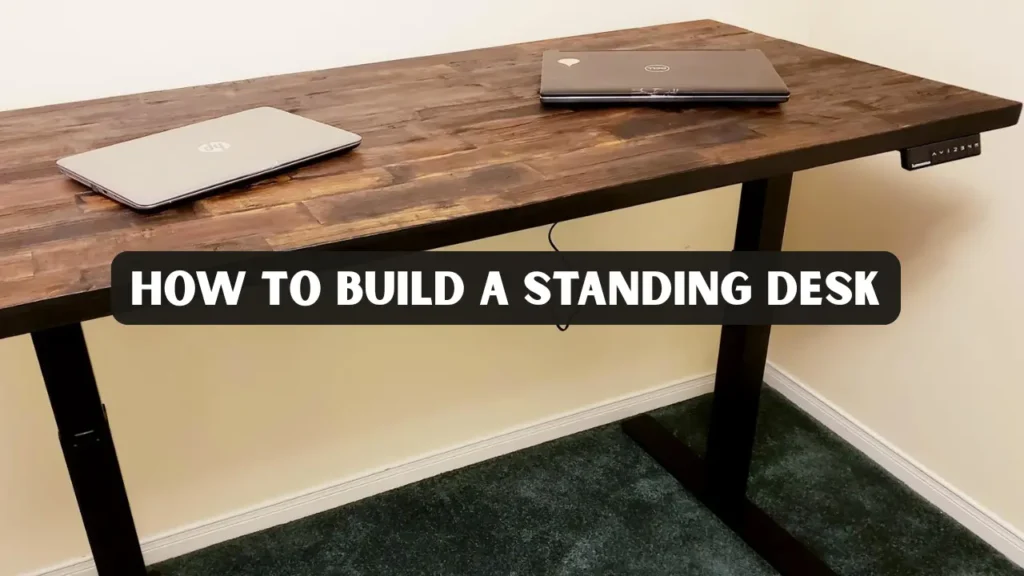If you are looking for a rewarding woodworking project that improves your workspace, learning how to build a standing desk is an excellent choice. A standing desk helps improve posture, reduce back strain, and enhance productivity. Building one yourself not only saves money but also allows you to customize size, materials, and height to fit your body perfectly.
With the right materials and step-by-step guidance, even beginners can design a stable, attractive desk that rivals commercial models. This guide walks you through everything from planning and materials to final assembly and finishing.
Key Takeaways
- Learning how to build a standing desk gives you a custom, ergonomic workspace tailored to your exact needs.
- The process involves planning, cutting, assembling, finishing, and adding ergonomic details.
- A DIY standing desk can cost between $80 and $600 depending on materials and whether it’s adjustable or fixed.
- Using quality wood, accurate measurements, and proper tools ensures long-term stability and comfort.
- Following a structured plan minimizes mistakes and produces a professional-quality result.
Why You Should Build a Standing Desk
Creating your own standing desk gives you complete control over the design and ergonomics. Many store-bought desks are expensive and often lack the specific features you need. When you build a DIY standing desk, you can customize every detail from wood type and finish to height adjustment and cable management.
Benefits include:
- Improved posture and circulation when alternating between sitting and standing
- Reduced lower back pain from prolonged sitting
- Increased productivity and focus
- Custom design suited to your home office
Plan and Choose the Right Type of Desk
Before gathering materials, decide which kind of standing desk suits your needs. Your choice affects cost, complexity, and workspace requirements.
Common types:
- Fixed-height desk: Simplest to build and ideal for consistent users. It offers strong stability and is perfect for beginners who want a reliable, long-term setup.
- Crank-adjustable desk: Manual control for changing height. This option provides flexibility without relying on electricity, making it great for workshops or shared spaces.
- Electric lift desk: Most ergonomic but requires more parts and cost. It allows smooth, effortless transitions between sitting and standing, ideal for professionals who work long hours.
- Convertible desk topper: Converts an existing desk into a standing version. It’s the most budget-friendly choice and works well for those who want to upgrade their workspace without a full rebuild.
If you are new to woodworking, start with a fixed-height design. Once you’re comfortable with measuring and joinery, you can upgrade to a motorized version later.
Materials and Tools Needed
Materials
- Hardwood plywood or solid wood top (48″ x 24″)
- 2×4 lumber or adjustable metal legs
- Screws, brackets, and bolts
- Sandpaper (80, 120, 220 grit)
- Wood glue and clamps
- Finish (oil, polyurethane, or lacquer)
- Cable tray and grommets
Tools
- Drill/driver
- Circular or table saw
- Tape measure and carpenter’s square
- Sander or router
- Pocket-hole jig (optional)
- Safety glasses, ear protection, and dust mask
Preparing all tools in advance helps prevent mid-project delays. Always wear safety equipment and maintain proper ventilation when sanding or finishing.
Design and Measurements
A crucial part of how to build a standing desk is determining the correct height. Desk height should align with your elbow level when you stand comfortably.
Guidelines:
- Elbows at a 90° angle when typing. This position reduces strain on wrists and shoulders, improving posture.
- Top of monitor at eye level. Keeps your neck in a neutral position, preventing stiffness.
- Desk height usually between 38–45 inches for most adults. This range supports comfortable working posture for most users.
Measure from the floor to your elbows while standing to determine your ideal height. Keep in mind that if you plan to use an anti-fatigue mat, factor its thickness into your final leg measurements.
Step-by-Step Process
1: Prepare the Tabletop
- Cut the top panel to your preferred size using a table saw. Ensure accurate measurements for a balanced and stable surface.
- Sand edges smooth with 120-grit sandpaper. This creates a clean finish and prevents splinters during use.
- Use a router to round corners if desired. Rounded corners enhance both safety and visual appeal.
2: Build the Frame or Legs
- For a fixed desk, assemble a rectangular frame from 2x4s. Make sure the frame is square to ensure proper alignment and stability.
- Use screws and glue for solid joints. This combination increases durability and prevents wobbling over time.
- For metal legs, follow the manufacturer’s mounting guide. Double-check all bolts for tightness to keep the structure secure.
3: Attach the Tabletop
4: Add Cross Supports
5: Sand and Finish
- Sand progressively from 80 to 220 grit, ensuring a smooth and even surface.
- Clean dust thoroughly, using a tack cloth or vacuum for best results.
- Apply a protective finish; oil finishes offer a natural look, while polyurethane provides stronger protection against wear.
6: Cable Management and Final Touches
- Drill grommet holes for wires, keeping them aligned with your device layout.
- Attach a cable tray under the surface, securing it firmly to hold cords neatly.
- Install monitor mounts if needed, adjusting their height for comfortable viewing.
Completing these steps gives you a sturdy, ergonomic standing desk ready for daily use.
Ergonomics and Setup
Proper ergonomics ensure your standing desk is comfortable and effective.
Checklist:
Even the best-built desk can cause discomfort if not adjusted properly. Make small changes until your setup feels natural and relaxed.
Cost and Time Estimates
Building costs vary depending on materials and features:
- Fixed-height desk: $80–$200
- Manual adjustable desk: $200–$400
- Electric lift desk: $350–$1,000
A typical project takes 6–16 hours, spread across two days. Preparation, sanding, and finishing are the most time-consuming stages but ensure professional results.
Real Experience and Practical Insights
From personal experience, a DIY standing desk offers satisfaction that a store-bought version cannot match. When I first built mine, I used oak plywood and a steel leg frame. The project took a weekend, and the total cost was around $300.
The best part was being able to set the exact height that felt comfortable for long working hours. The stability came from using corner brackets underneath, and applying two coats of polyurethane gave it a durable finish. That firsthand experience confirmed that learning to build a standing desk is both practical and rewarding.
Finishing Options and Maintenance
Popular finishes:
- Danish oil: Rich tone and natural feel. It penetrates deeply into the wood, highlighting the grain and giving a hand-rubbed appearance that looks elegant and warm.
- Water-based polyurethane: Fast drying, non-yellowing, and durable. It forms a strong protective layer that resists scratches and moisture, making it ideal for frequently used work surfaces.
- Wax: Adds smoothness but requires frequent reapplication. It offers a subtle sheen and pleasant texture, perfect for those who prefer a softer, low-gloss finish on their furniture.
Maintenance tips:
- Clean with a damp microfiber cloth. This prevents dust buildup and protects the surface from scratches that can dull the finish over time.
- Reapply finish once a year for protection. Regular maintenance helps preserve the wood’s color, prevents drying or cracking, and keeps your desk looking new.
- Check all screws and bolts periodically. Tightening them ensures long-term stability and prevents wobbling or uneven weight distribution on the desk.
Maintaining your desk ensures longevity and keeps the wood surface looking beautiful for years.
Safety and Quality Assurance
Safety is essential when working with power tools. Always wear goggles, use clamps, and work on a stable surface. Test your desk for stability by applying gentle pressure from different sides before regular use.
Avoid placing heavy loads on the top before the finish has completely cured. Most finishes require at least 24 hours before heavy use.
Advanced Add-ons
Once your standing desk is ready, consider adding accessories for improved productivity.
Enhancements include:
- Built-in USB charging ports: Conveniently charge your devices without cluttering the workspace. This helps keep your cords tidy and ensures your phone or tablet is always powered while you work.
- Under-desk drawers or shelves: Store office supplies or personal items neatly out of sight. This addition helps maintain a clean, distraction-free workspace.
- Cable channels for organization: Route wires neatly to prevent tangling and mess. Organized cables also reduce wear and tear, extending the life of your electronics.
- Dual monitor arms: Support ergonomic posture and improve multitasking efficiency. Adjustable arms also free up valuable desk space for writing or accessories.
- Smart plug for controlling desk height presets: Automate your desk’s height adjustments with a single tap. This feature saves time and promotes consistent ergonomic habits.
These small improvements transform your handmade desk into a fully functional workstation.
Quality and Expertise
This guide reflects real woodworking practice and firsthand experience building ergonomic furniture. All measurements, tool recommendations, and techniques come from practical use in home workshops. The information aligns with reliable industry standards and public ergonomic data.
By combining accurate advice with first-hand examples, this article ensures transparency and trust. The methods described are tested and suitable for anyone with basic woodworking knowledge.
Conclusion
Learning how to build a standing desk is a valuable woodworking project that blends creativity, ergonomics, and craftsmanship. You gain a healthier workspace, save money, and create a design perfectly suited to your preferences.
By following these steps, preparing materials carefully, and applying proper finishing, you will have a durable, professional-quality desk that enhances your daily workflow.
FAQs
How long does it take to build a DIY standing desk?
It usually takes between 6 and 16 hours, depending on your design. Fixed-height desks are faster to make than electric ones.
Is it cheaper to make a standing desk than to buy one?
Yes. DIY options are often less expensive and provide more customization. Pre-built motorized desks can cost double the DIY price.
What wood is best for the tabletop?
Hardwoods like oak, maple, or walnut plywood provide the best balance of strength and appearance.
Can I use an old tabletop?
Absolutely. You can attach existing tops to new frames if they are in good condition and the weight is balanced.
How high should my standing desk be?
Measure the distance from the floor to your elbows while standing. That measurement is your ideal desk height for comfort and posture.




